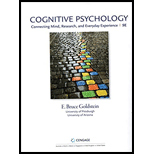
Introduction
The different methods of observation, in the field of psychology, that contribute to an individual understanding are known as levels of analysis. Any topic of consideration in psychology can be explained using three approaches: cognitive, biological, and sociocultural.
Explanation of Solution
Answer and explanation
To understand the concept of levels of analysis, one can take into consideration an example from the realm of psychology. In this, if an individual wants to obtain an understanding of depression as a disorder, through the biological level of analysis, he/she would most likely rely on the observations of physiological aspects of the brain (functioning of neurons), the role of genes, and the functioning of hormones in a patient suffering from depression. Methods that can be employed in the biological level of analysis are laboratory experiments, naturalistic observation, correlation studies, or twin studies.
In the cognitive level of analysis, a person gains an understanding of how the mental processes perform functions like thinking, perceiving, paying attention, memorizing, and acquiring languages. Considering the aforementioned example to understand the cognitive functioning of a patient with depression, their behavior can be measured in different situations by introspection of their thoughts, memories, perceptions, and other cognitive functions.
Similarly, in order to analyze a person suffering from depression through the sociocultural level of analysis, the patient's interaction with their environment and the way in which other people in their surroundings influence them (their conformity and compliance) could be recorded.
Therefore, integrating these factors is an essential aspect as it is capable of providing a complete, satisfactory, and comprehensive understanding of a phenomenon or behavior and reflects the contemporary trends in psychology.
Want to see more full solutions like this?
Chapter 2 Solutions
COGNITIVE PSYCHOLOGY - WITH MINDTAP
- what makes yoruba different from other religions or culturesarrow_forwardWhat does the PIC/NIC Analysis focus on from the Performer's Perspective? Consequences Antecedents Behavior X Behavior Yarrow_forwardWhat does the PIC/NIC Analysis focus on from the Performer's Perspective? Consequences Antecedents Behavior X Behavior Yarrow_forward
- The Performance Diagnostic Checklist-Human Services (PDC-HS) is an assessment tool to identify areas of improvement for employee performance within a work environment. For this task, you can complete the PDC-HS as a self-assessment within your work requirements or you can interview a colleague. Describe the performance concernarrow_forwardWhat are three methods for dissemination of information that school counselors can use after watching the YouTube video titled: “Self-care for school counselors” (https://www.youtube.com/watch?v=hvQyjEh1Lmk) by CSCA Executive Director (2020, April 2)? Please write in a narrative format and include citations and references.arrow_forwardWhat are the three most relevant principles school counselors need to be aware of watching the YouTube video titled: “Self-care for school counselors” (https://www.youtube.com/watch?v=hvQyjEh1Lmk) by CSCA Executive Director (2020, April 2))? Please write in a narrative format and include citations and references.arrow_forward
- What are three interventions or programs school counselors can implement in schools after watching the YouTube video titled: “Self-care for school counselors” (https://www.youtube.com/watch?v=hvQyjEh1Lmk) by CSCA Executive Director (2020, April 2))? Please write in a narrative format and include citations and references.arrow_forwardWhat are three professional best practices that school counselors can implement or can recommend in schools after watching the YouTube video titled: “Self-care for school counselors” (https://www.youtube.com/watch?v=hvQyjEh1Lmk) by CSCA Executive Director (2020, April 2))? Please write in a narrative format and include citations and references.arrow_forwardWhat are three strategies school counselors use in schools after watching the YouTube video titled: “Self-care for school counselors” (https://www.youtube.com/watch?v=hvQyjEh1Lmk) by CSCA Executive Director (2020, April 2)? Please write in a narrative format and include citations and references.arrow_forward
- What are three most important knowledge a school counselor can gain from watching the YouTube video titled: “Self-care for school counselors” (https://www.youtube.com/watch?v=hvQyjEh1Lmk) by CSCA Executive Director (2020, April 2))? Please write in a narrative format and include citations and references.arrow_forwardDraft your PowerPoint Outline for Chapter 12. Toward Behavior Analytic Practice in Augmentative and Alternative Communication (AAC) in Roane, H.S., Ringdahl, J.E., & Falcomata, T.S. (Eds.). (2015). Clinical and organizational applications of Applied Behavior Analysis. Develop sections based on chapter summary EDSE 624 - Applied Behavior Analysis: Applications Discussion Leader Presentation Assignment Instructions Embed objectives in beginning Include 2-3 student objectives related to the chapter content Include 1-2 BACB Task List items that best match the content Embed main message in the middle and end Add Visuals Keep your visuals structures, simple and clear Select a consistent theme, color scheme, etc. Create header slides from outline and add additional content slides under each Paste in detailed outline information, then edit text to simple bullets or images Limit distracting stimuli (e.g. organization branding, distracting animations) Ensure visuals are clear from the…arrow_forward1. a. Explain in detail Freud’s stages of psychosexual development. b. Briefly explain the different forms of ego defence mechanism 2. Explain in detail Piaget’s stages of cognitive development, citing relevant examples.arrow_forward
 Ciccarelli: Psychology_5 (5th Edition)PsychologyISBN:9780134477961Author:Saundra K. Ciccarelli, J. Noland WhitePublisher:PEARSON
Ciccarelli: Psychology_5 (5th Edition)PsychologyISBN:9780134477961Author:Saundra K. Ciccarelli, J. Noland WhitePublisher:PEARSON Cognitive PsychologyPsychologyISBN:9781337408271Author:Goldstein, E. Bruce.Publisher:Cengage Learning,
Cognitive PsychologyPsychologyISBN:9781337408271Author:Goldstein, E. Bruce.Publisher:Cengage Learning, Introduction to Psychology: Gateways to Mind and ...PsychologyISBN:9781337565691Author:Dennis Coon, John O. Mitterer, Tanya S. MartiniPublisher:Cengage Learning
Introduction to Psychology: Gateways to Mind and ...PsychologyISBN:9781337565691Author:Dennis Coon, John O. Mitterer, Tanya S. MartiniPublisher:Cengage Learning Psychology in Your Life (Second Edition)PsychologyISBN:9780393265156Author:Sarah Grison, Michael GazzanigaPublisher:W. W. Norton & Company
Psychology in Your Life (Second Edition)PsychologyISBN:9780393265156Author:Sarah Grison, Michael GazzanigaPublisher:W. W. Norton & Company Cognitive Psychology: Connecting Mind, Research a...PsychologyISBN:9781285763880Author:E. Bruce GoldsteinPublisher:Cengage Learning
Cognitive Psychology: Connecting Mind, Research a...PsychologyISBN:9781285763880Author:E. Bruce GoldsteinPublisher:Cengage Learning Theories of Personality (MindTap Course List)PsychologyISBN:9781305652958Author:Duane P. Schultz, Sydney Ellen SchultzPublisher:Cengage Learning
Theories of Personality (MindTap Course List)PsychologyISBN:9781305652958Author:Duane P. Schultz, Sydney Ellen SchultzPublisher:Cengage Learning





